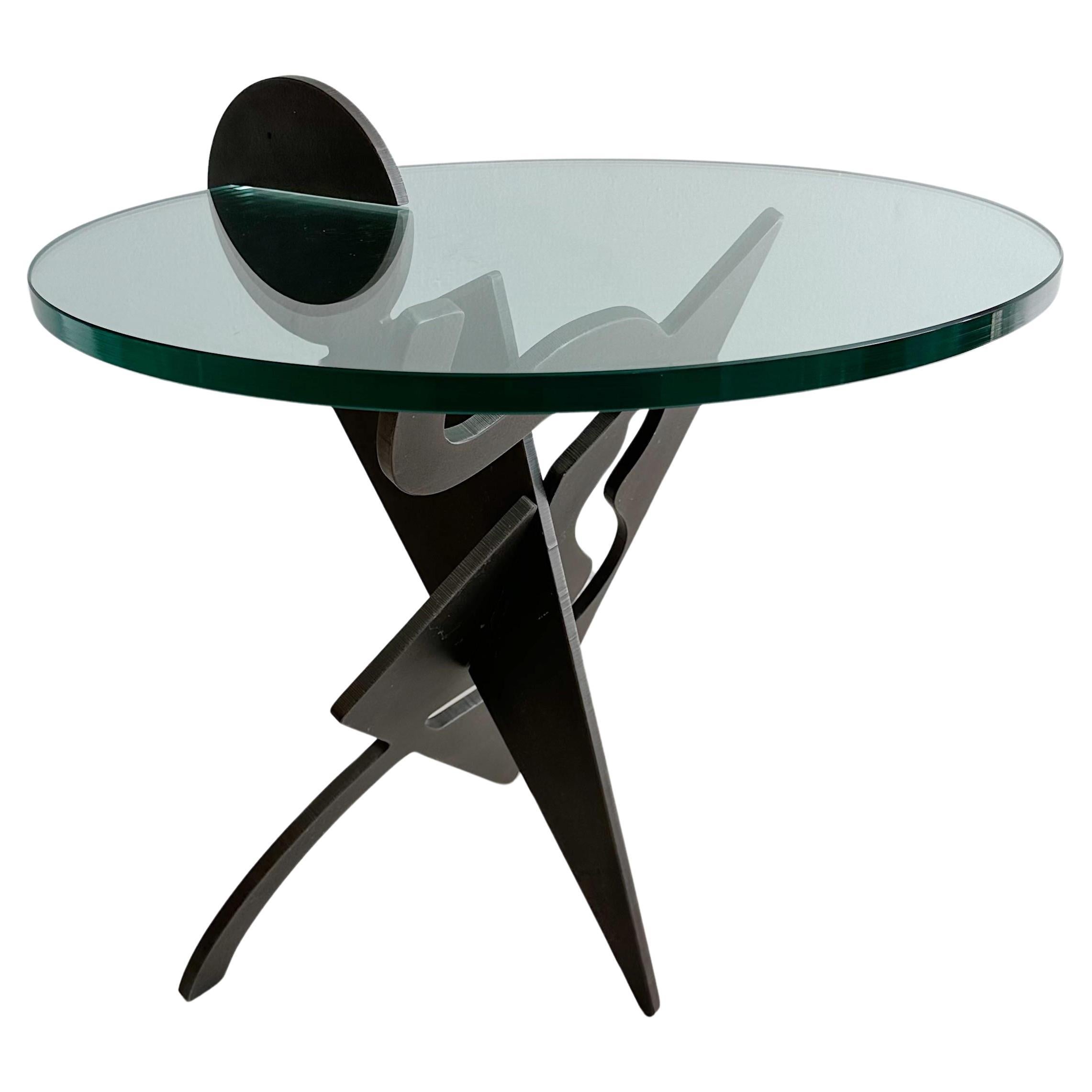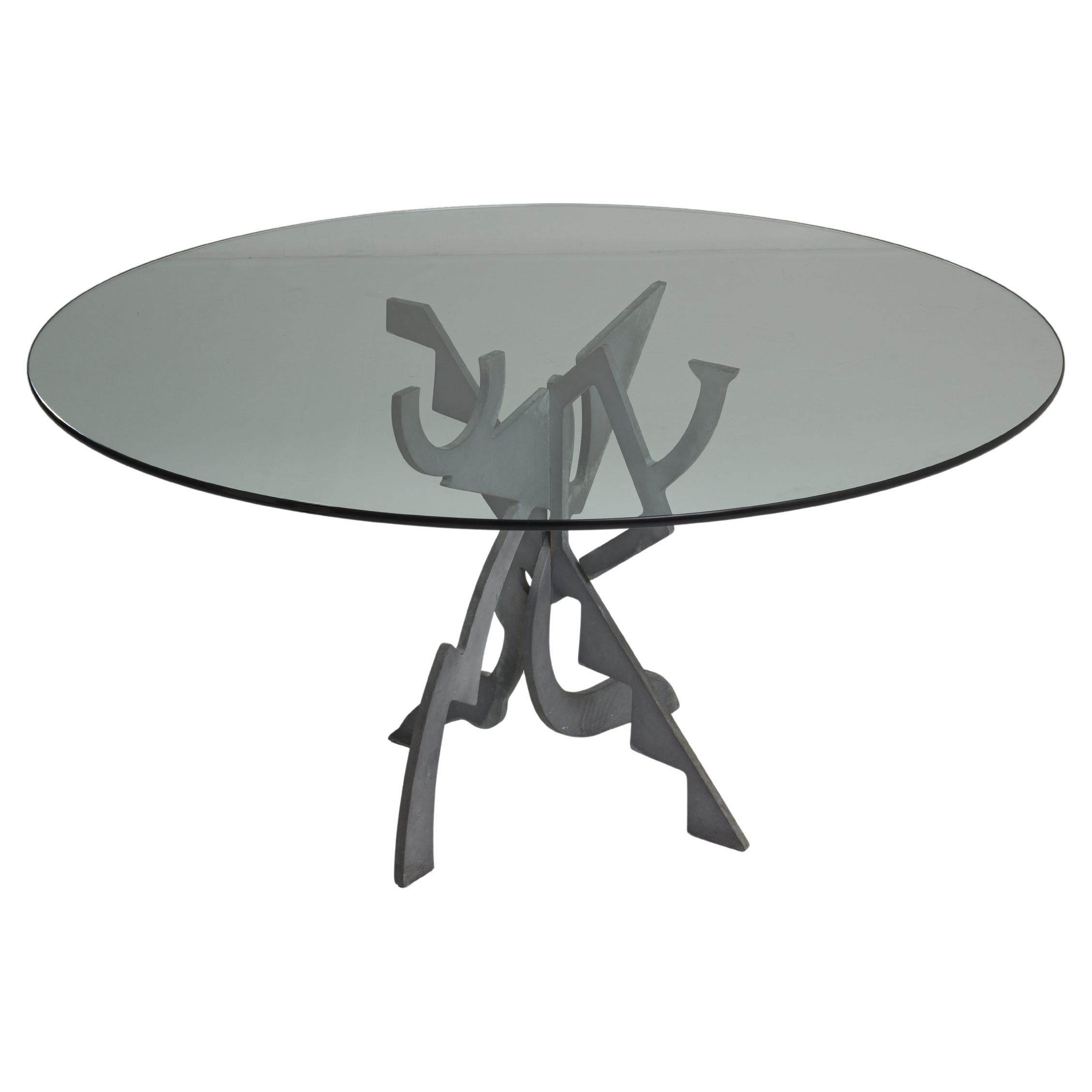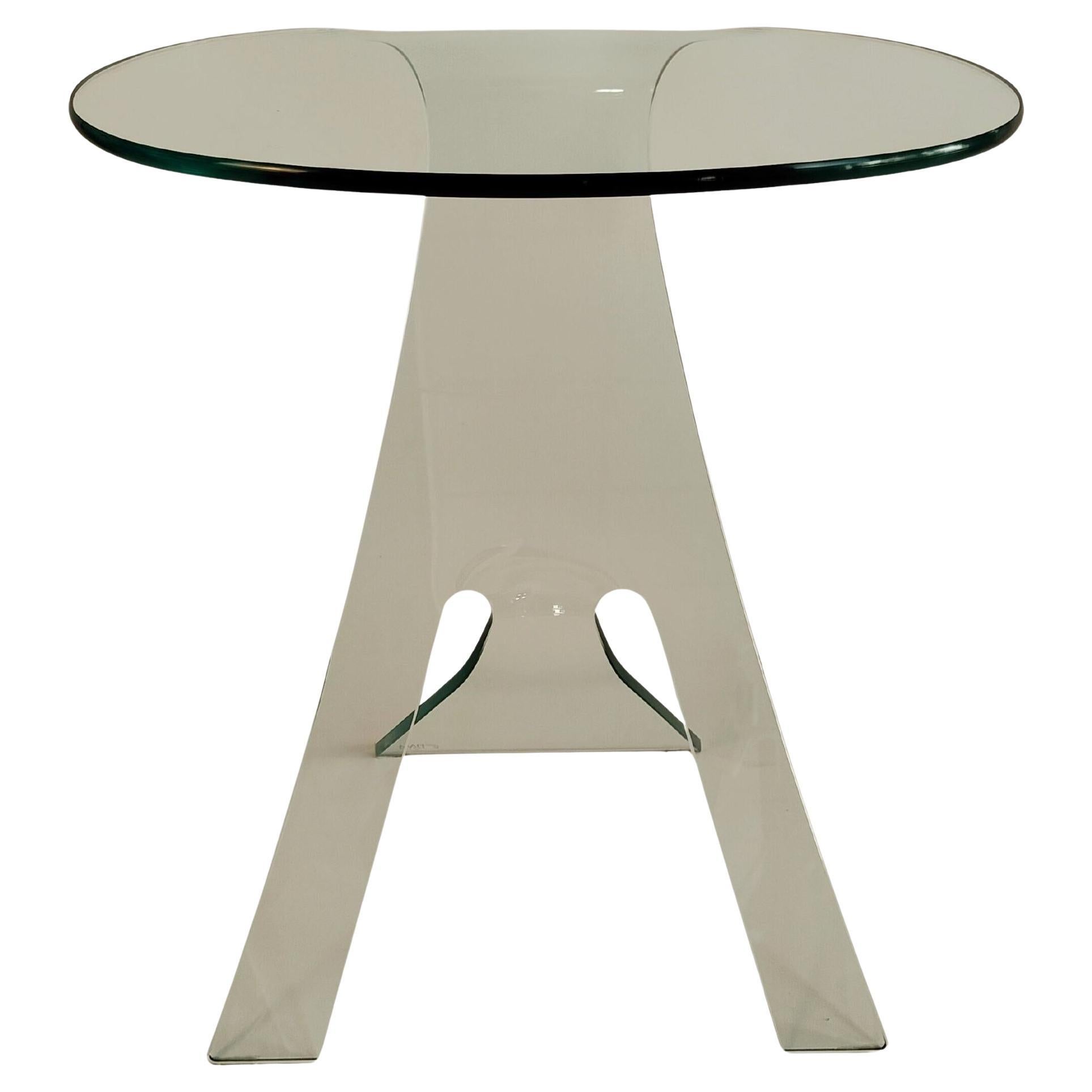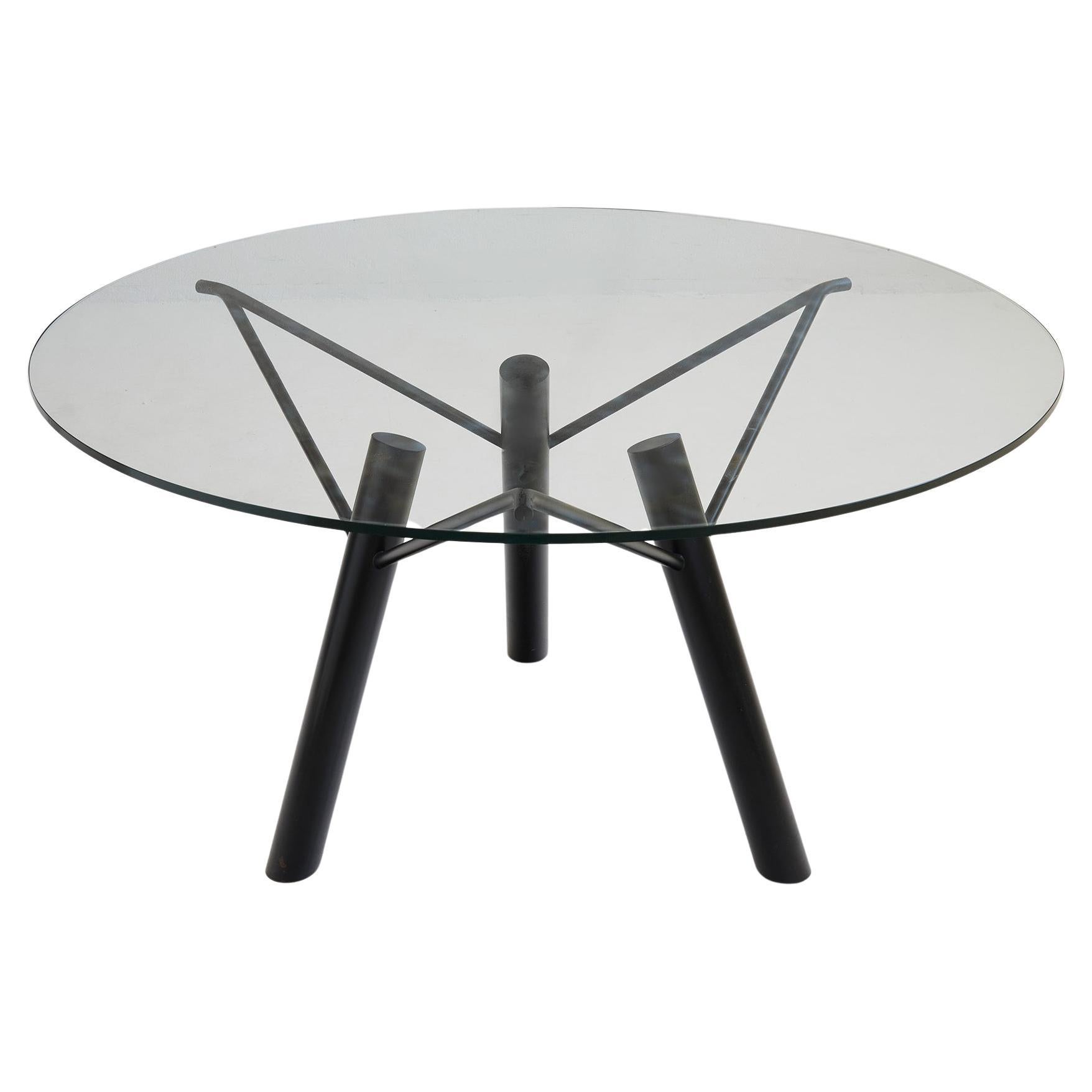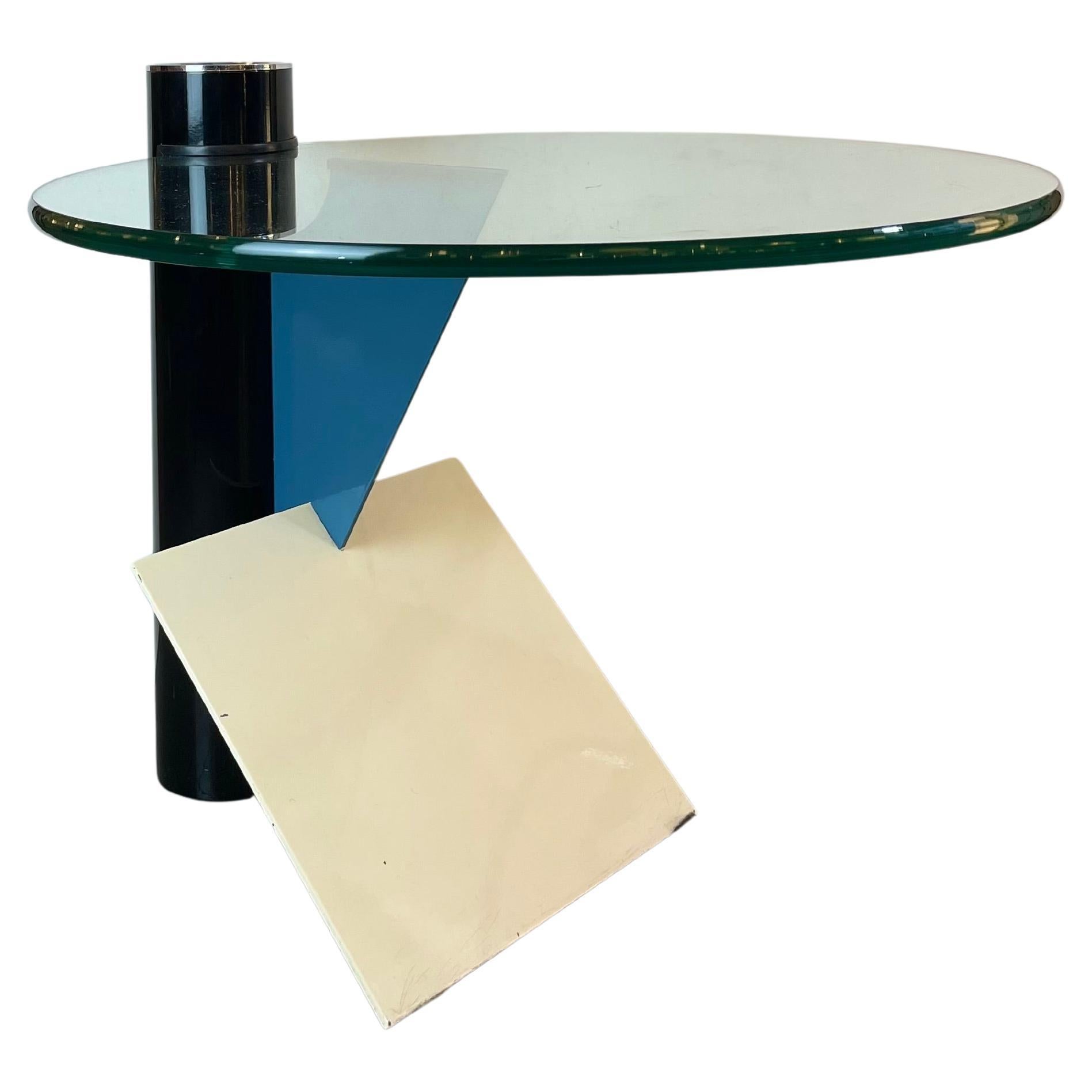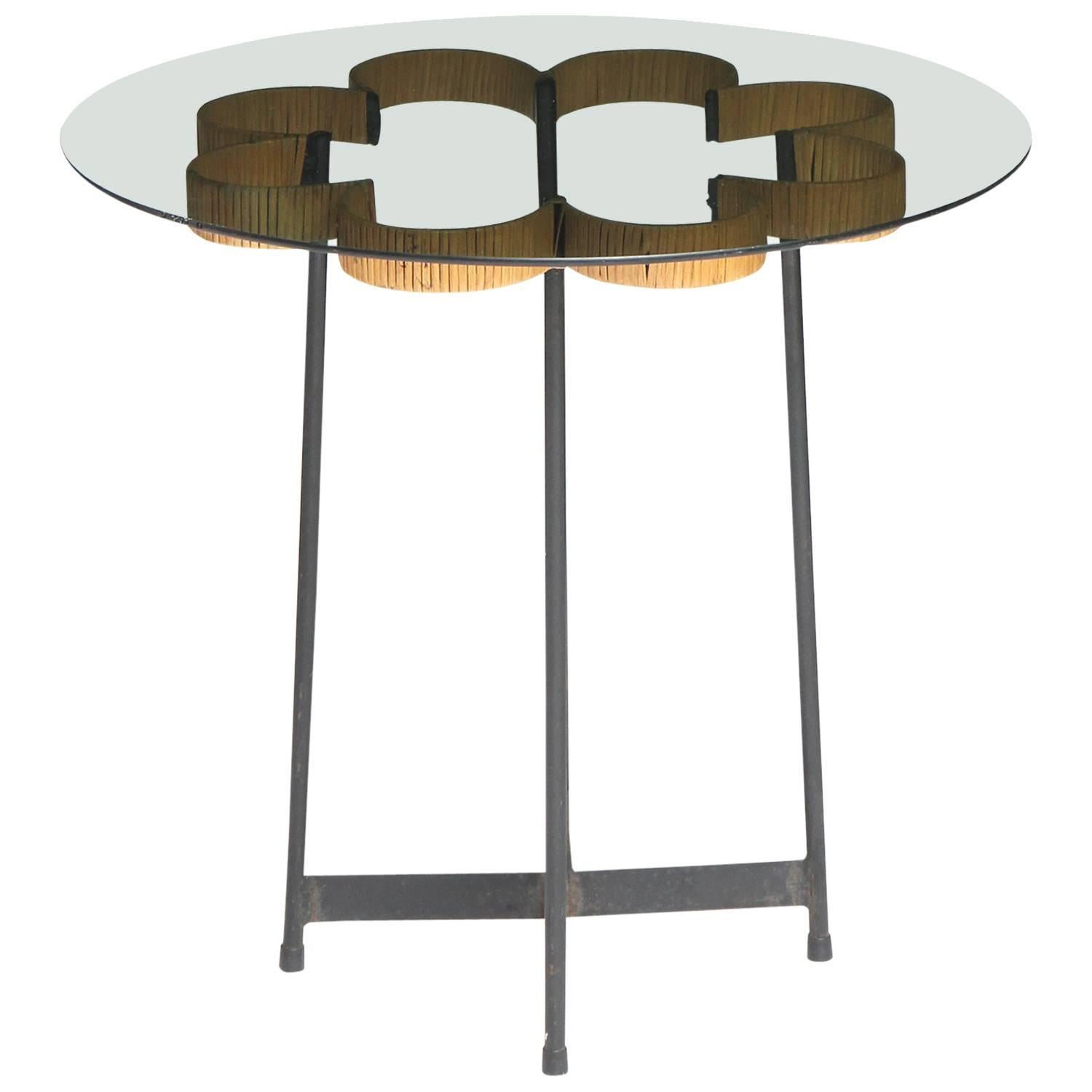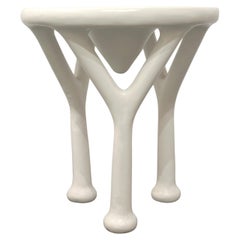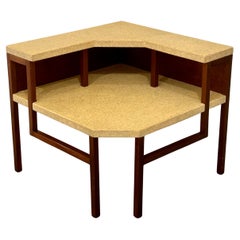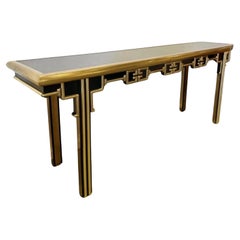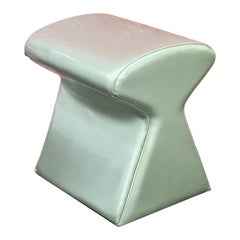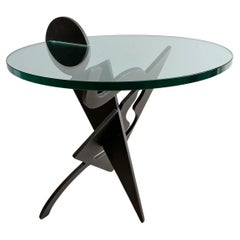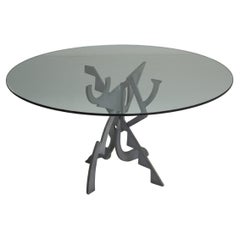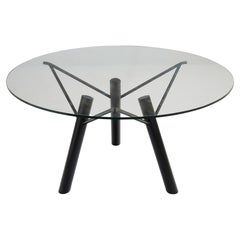Artículos similares a Pucci De Rossi for H Dolin Stuart Signed Battista Occasional Table, 1987
Cargando vídeo
¿Quieres más imágenes o vídeos?
Solicita imágenes o vídeos adicionales al vendedor
1 de 16
Pucci De Rossi for H Dolin Stuart Signed Battista Occasional Table, 1987
2434,50 €
Acerca del artículo
Pucci De Rossi for H Dolin Stuart Signed Battista Occasional Table, 1987
A delightful postmodern sculptural side table with an interlocking charcoal color metal base with glass top by Italian-born, Paris-based designer and artist Pucci de Rossi. Signed and dated 1987 at the base.
The. table measures 28" high x 23-1/2" wide x 22" deep overall. The glass top is 3/4' thick and measures 22" diameter. The glass top surface is 24-3/8" high.
There are some light scratches in the glass that are not distracting when viewed at a normal distance. There is a chip at the edge of the glass that presents as green but is hidden where the glass attaches under the frame so it is not seen. Otherwise, light scratches as expected in an item of this age, See photos for full condition. In rather remarkable condition for its vintage.
Among the army of designers from the 1980s and ’90s plucked from the archive in recent years — Ettore Sottsass, Nathalie du Pasquier, and their Memphis cohort, to name a few — there are still many that remain ripe for rediscovery. Our latest find is Pucci de Rossi, the Italian-born artist and designer who intrigued and confused the Parisian design world with his Brutti Mobili (Ugly Furniture). A clear predecessor to a whole cohort of artist-designers working today — think Misha Kahn’s mixed media chimeras — Pucci de Rossi didn’t invent the concept of functional art, but his work from the 1970s to 1990s certainly laid some groundwork.
Born in the Northern Italian city of Verona, Pucci was a tinkerer at heart. The trajectory of his practice simply followed what kind of materials were available to him at the time. In the early days, under the tutelage of American sculptor Brooks Walker, he worked with found objects, gathering old furnishings and discarded objects to create Frankenstein-like medleys inspired by the Surrealist paintings of Dalí and De Chirico at his home on the banks of the Adige river. “Pucci began his artistic life before the arrival of Postmodern design,” writes Nancy Huston in a monograph dedicated to his work, “at a time when no one raised the problems of the relationship between artists and artisans, and the word ‘design’ had not yet undergone the inflation that we know today.”
A contemporary of the Memphis movement, he held Ettore Sottsass and his ilk in high regard, but, recalls his widow, gallerist Mathilde Baralhé: “Pucci did not define himself as a designer but more as a visual artist, he designed his own objects and very rarely worked for serialization. He was therefore not constrained by any technical specifications and could let his imagination run wild. He was a creator of forms in space which kept a function to his creations. Pucci was a sculptor who played with furniture, shapes, materials and styles.”
In the 1970s, Pucci left Vicenza and moved to Paris with his first wife, the French writer and artist Laure Vernière. Arriving in the capital signaled a creative boom time for Pucci. From his flat in the Bastille district, he would scour the streets collecting detritus from the artisans and craftspeople that populated the neighborhood, which he would then transform into his infinitely kinetic assemblages: “Zinc torn off the roof by the roofers, abandoned furniture, debris of all sorts could be found on the sidewalks. All these materials, tools, bistro awnings, old signs, ordinary wood, wire, plastic… were a gold mine for me… I could find everything in the neighborhood. After, came the idea,” he once said.
In the monograph, Huston describes these amalgams as anthropomorphic furniture. “The seats can’t stand still,” she writes. “Structures are crossed by fluid forms; struck by a cramp, a Chippendale leg becomes taut, its lion’s claws have dropped their ball. The seats become animated, their backs, their legs and their arms start to move. An Art Nouveau curve balances a molding with a right angle, improbable compartments with their knobs act as the left arm. Under the undulating seat are four disparate legs: a baroque scroll, a baluster and two geometric volumes. Asymmetrical, dislocated, lop-sided, the monster leaning on its crutch seems to raise its shoulder to start a burlesque dance or to flee, like Dr. Frankenstein’s creature or the furniture of Maupassant’s short story.”
Despite his prolificacy, it wasn’t until the mid-80s that Pucci could be tacked on to a coherent design movement. As his profile grew, he became known as the continental answer to the group called ‘The London Scrapdealers’ — an ad hoc movement made up of André Dubreuil, Tom Dixon, Mark Brazier Jones and Nick Jones who similarly employed found objects and contorted junk metal in their work. It was a mode of working that was unstudied and untaught, a reaction to the 1980s chrome-plated minimalism. “People were fed up with the minimal, they wanted curves and what they liked was the salvaging aspect, messed up, Arts & Crafts, to use the English term. We didn’t do drawings, we executed spontaneously,” Dubreuil said of the early Postmodernists. Finally, the style Pucci had been nurturing for decades was having a moment.
It was around this time that Pucci began working with Paris gallery Néotu, where he would produce a succession of collections in his proto-Nickelodeon aesthetic. Distorted furniture inspired by Dali (Hommage à Dalí, 1989), deconstructivist-style three-dimensional collages in metal and wood (Introibo ad altare dei, 1987) lamps spliced with shards of glass (Le Gardien du trésor, 1985), undulating plywood monoliths (Trois Fois rien,1991) and steampunk-like assemblages of wooden artifacts gleaned from forgotten chairs (Remake, 1993) all became examples of Pucci’s dogged eclecticism.
Paris also introduced Pucci to the kind of patrons who would allow his creative impulses to run free. The most influential among them was auctioneer Jean-Claude Binoche, known for his contemporary art and design sales, who commissioned Pucci to design the dining room and office in his Paris home, and later on, his sprawling Palazzo in Venice, which would become the most fully realized expression of Pucci’s idiosyncratic melding of art and design. A built-in sleigh bed formed in the shape of baroque scrolls, hand-painted technicolor murals on the building’s ancient rafters and furniture plucked from Pucci’s various collections over the years made up the extravagantly bizarre Venetian home.
“A man apart, gifted with overflowing ingenuity and inventiveness. It was not always easy to follow his thoughts every day, he was always thinking about the meaning of things, of life, of himself,” recalls Mathilde, who lived with Pucci at his Bastille apartment until he passed away in 2013.
Of his legacy, she writes: “The object that reflects this feeling is the J.A.R. mirror (Jamais Assez De Reflection/Never Enough Reflection), on one side a mirror, on the other a self-portrait. But unlike many other artists, Pucci was not self-centered, he was very available with his friends and relatives. He was very sensitive to people. He could be light and deep at the same time. He followed the impulses of his heart. But he was also a bon vivant who liked to party. What I liked about him was his humor, his mischievousness and the offbeat vision he had of the world: ‘I have to constantly change the reality that surrounds me, my work is an example of this and it is perhaps the way of expressing myself that suits me best’ [he once said]. Living with Pucci was like living a daydream. He was an everyday poet.”
Source: Sight Unseen
- Creador:Pucci De Rossi (Diseñador)
- Dimensiones:Altura: 71,12 cm (28 in)Anchura: 59,69 cm (23,5 in)Profundidad: 55,88 cm (22 in)
- Estilo:Posmoderno (Del período)
- Materiales y técnicas:
- Lugar de origen:
- Época:1980-1989
- Fecha de fabricación:1987
- Estado:Desgaste acorde con la edad y el uso. There are some light scratches in the glass that are not distracting when viewed at a normal distance. There is a chip at the edge of the glass that presents as green and but is hidden where the glass attaches under the frame.
- Ubicación del vendedor:Cathedral City, CA
- Número de referencia:Vendedor: OC98651stDibs: LU8352245433332
Sobre el vendedor
5,0
Vendedor Oro
Vendedores premium que mantienen una calificación de +4,3 y tiempos de respuesta de 24 horas
Establecido en 2000
Vendedor de 1stDibs desde 2023
23 ventas en 1stDibs
Tiempo de respuesta usual: <1 hora
- EnvíoRecuperando presupuesto…Envío desde: Cathedral City, CA
- Política de devolución
Partes de esta página se han traducido automáticamente. 1stDibs no puede garantizar la exactitud de las traducciones. El inglés es el idioma predeterminado de este sitio web.
Garantía de autenticidad
En el improbable caso de que haya algún problema con la autenticidad de un artículo, ponte en contacto con nosotros en un plazo de 1 año para recibir un reembolso total. DetallesGarantía de devolución de dinero
Si tu artículo no es como se describe, sufre daños durante el transporte o no llega, ponte en contacto con nosotros en un plazo de 7 días para recibir un reembolso total. DetallesCancelación dentro de las 24 horas
Tienes un período de gracia de 24 horas para reconsiderar tu compra, sin preguntas.Vendedores profesionales aprobados
Nuestros vendedores de primera clase deben cumplir estrictos estándares de servicio para mantener la integridad de nuestros anuncios.Garantía de igualación de precios
Si encuentras que un vendedor publicó el mismo artículo por un precio menor en otro lado, igualaremos ese precio.Entrega global de confianza
Nuestra red de transporte de primera ofrece opciones de envío especializado en todo el mundo, que incluye envío personalizado.Más de este vendedor
Ver todoMesa en Y lacada John Dickinson, ca. 1970
Por John Dickinson
Mesa en Y lacada John Dickinson, ca. 1970
Se trata de una rara mesa en Y (modelo 118) de resina lacada, diseñada por John Dickinson. Es una mesa especial y encajaría en una gran var...
Categoría
Vintage, Década de 1970, Estadounidense, Moderno orgánico, Mesas auxiliares
Materiales
Resina, Laca
Paul Frankl para Johnson Furniture Mesa esquinera de corcho y caoba, ca 1951
Por Johnson Furniture Company, Paul Frankl
Paul Frankl para Johnson Furniture Mesa esquinera de corcho y caoba, ca 1951
Singular mesa esquinera grande que quedaría perfecta con dos sofás grandes de mediados de siglo colocado...
Categoría
mediados del siglo XX, Estadounidense, Moderno de mediados de siglo, Mes...
Materiales
Caoba, Corcho
Mastercraft USA Elegante consola de laca negra y latón, ca. 1970
Por Maitland Smith
Mastercraft USA Elegante consola de laca negra y latón, ca. 1970
Impresionante y larga consola Mastercraft de laca negra y latón con motivo de llave griega. Se trata de una pieza f...
Categoría
Vintage, Década de 1970, Estadounidense, Regencia de Hollywood, Mesas de...
Materiales
Latón
Karim Rashid Taburete de vinilo plateado con forma de seta para IDEE Edición limitada firmada y numerada
Por Idée Japan, Karim Rashid
Karim Rashid Taburete Champiñón diseñado para IDEE, Japón, en 1998. Esta versión en vinilo plateado fue una edición limitada y está firmada y numerada con el nº 4/57 en la tela con l...
Categoría
Década de 1990, Japonés, Futurista, Taburetes
Materiales
Tapicería, Sintético, Espuma, PVC
Daniel Pollock Taburete u objeto escultórico moderno orgánico de madera de pino tallada, 1995
Por Daniel Pollock
Daniel Pollock Taburete moderno orgánico de madera tallada u objeto escultórico tallado a mano en madera de pino. Es una pieza muy pesada y las imperfecciones no hacen sino añadir en...
Categoría
Década de 1990, Estadounidense, Moderno orgánico, Taburetes
Materiales
Madera, Pino
Lámpara de mesa sobredimensionada Yasha Heifetz Rotaflex, ca. 1950
Por Heifetz, Heifetz Rotaflex, Yasha Heifetz
Lámpara de sobremesa Yasha Heifetz Rotaflex, ca. 1950
Una versión poco común de la lámpara Heifetz Rotaflex que presenta una pantalla de cuerda de plástico hilado que descansa dentr...
Categoría
mediados del siglo XX, Estadounidense, Moderno de mediados de siglo, Lám...
Materiales
Metal, Latón
También te puede gustar
Pucci De Rossi (1947-2013) Mesa auxiliar "Battista
Por Pucci De Rossi
Pucci De Rossi
(1947-2013)
Mesa auxiliar con dos paneles entrelazados de acero de ⅝" de grosor cortados en formas abstractas con una pieza de cristal nuevo de 3/4" x24" que se desliz...
Categoría
Vintage, Década de 1980, Estadounidense, Moderno de mediados de siglo, M...
Materiales
Acero de corte
Escultura de mesa Pucci De Rossi 'Tristán e Isolda' H. Dolin Stuart Francia 1987
Por Pucci De Rossi
PUCCI DE ROSSI (1947-2013) Y H. DOLIN STUART
Mesa "Tristán e Isolda", diseñada en 1978, producida en 1987, estructura de acero lacado gris y tablero de cristal.
Edición Neotu
Al 73,5...
Categoría
Vintage, 1980s, French, Moderno, Mesas
Materiales
Hierro
FIAM Italia Mesa de centro 'Grillo' de Vittorio Livi, cristal curvado, Italia, 1980
Por FIAM, Vittorio Livi
Mesa de centro Grillo de cristal curvado diseñada por Vittorio Livi para FIAM Italia hacia los años 80. Una sola hoja de vidrio curvado de 62x53x39 cm y 12 mm de grosor. Diseño moder...
Categoría
Vintage, 1980s, Italian, Posmoderno, Mesas ratonas
Materiales
Cristal
Mesa de comedor "Orrido Canyon" de Mireille Rivier y Paolo Pallucco, Italia 1987
Por Pallucco, Paolo Pallucco & Mireille Rivier
Mesa de comedor "Orrido Canyon" de Mireille Rivier y Paolo Pallucco, Italia 1987
Presenta una base de forma escultural con tres patas cilíndricas en ángulo. La tapa redonda de crist...
Categoría
Vintage, Década de 1980, Italiano, Posmoderno, Mesas de comedor
Materiales
Metal
Mesa auxiliar posmoderna Memphis de Peter Shire para Saporiti, años 80u2028
Por Saporiti, Peter Shire
Rara mesa auxiliar postmoderna Memphis de base de acero esmaltado en negro, azul y beige, con tablero de disco de cristal y ordenata cromada. Diseñado por Peter Shire para la marca i...
Categoría
Vintage, Década de 1980, Italiano, Posmoderno, Mesas auxiliares
Materiales
Acero, Cromo
Mesa auxiliar de Arthur Umanoff
Por Tony Paul
Una expresiva y poco común mesa auxiliar con tablero de cristal, con forma de ocho bucles unidos envueltos en ratán que flotan sobre una estructura arquitectónica en forma de X.
Categoría
Vintage, Década de 1950, Estadounidense, Moderno de mediados de siglo, M...
Materiales
Vidrio, Ratán
